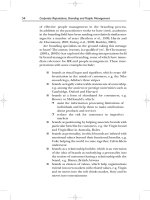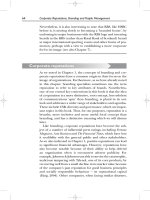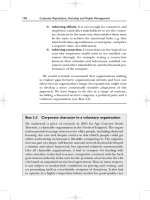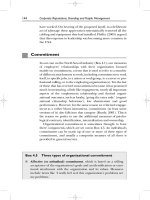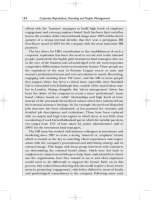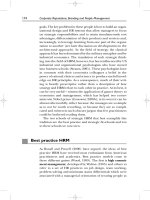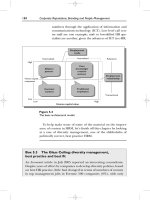Risk Assessment and Risk Management, II doc
Bạn đang xem bản rút gọn của tài liệu. Xem và tải ngay bản đầy đủ của tài liệu tại đây (392.19 KB, 9 trang )
Page 1
Risk Assessment
and Risk Management, II
Principles of Environmental Toxicology
Instructor: Gregory Möller, Ph.D.
University of Idaho
Principles of Environmental Toxicology
2
Modeling Risks
• “All models are wrong; some models are useful.”
George Box
Principles of Environmental Toxicology
3
Why Model Risks?
• Generally, modeling is performed to:
– Better understand a system.
– Make predictions.
• Specifically, risk modeling is often necessary
because:
– Acceptable risk levels are
not measurable.
– Direct sampling is not
feasible.
Principles of Environmental Toxicology
4
Point-Deterministic Approach
0.00 11.75 23.50 35.25 47.00
Exposure Duration (years)
ED
0 2,000 4,000 6,000 8,000
Exposure (EF*ET -hr/yr)
EF
29.26 30.69 32.11 33.54 34.96
Concent ration
CC
36.53 61.22 85.92 110.61 135.30
Body Wei ght (kg)
BW
1.53e-7 1.35e-5 2.67e-5 4.00e-5 5.33e-5
Toxici ty Factor (mg/kg d)
TF
CR
RISK
2.39 298.68 594 .98 891 .27 1,187.57
Contact Rate
Risk = TF x CC x CR x EF x ED
BW
Principles of Environmental Toxicology
5
Monte Carlo Simulation
Definition
• A technique by which a prediction is calculated
repeatedly using randomly selected what-if trials.
• The results of numerous trials are plotted to
represent a frequency distribution of possible
outcomes allowing the
likelihood of each such
outcome to be estimated.
Principles of Environmental Toxicology
6
Monte Carlo Simulation
History
• Games of chance were used in the late 19th and
early 20th centuries to infer outcomes.
– e.g., π was estimated by how often a haphazardly tossed
pin intersected lines on a grid.
• The term, “Monte Carlo,” came
into use to describe this process
at Los Alamos National Laboratory
in the late 1940s. Intensive
application of the process started
in the 1950s.
Page 2
Principles of Environmental Toxicology
7
Available Tools
• Excel
or Lotus
Monte Carlo simulation add-
in programs.
•Crystal Ball
– User friendly.
– Good graphics.
• @Risk
– Powerful.
– Large selection of distributions.
Principles of Environmental Toxicology
8
Stochastic Approach
0.00 11.75 23.50 35.25 47.00
Exposure Duration (years)
ED
0 2,000 4,000 6,000 8,000
Exposure (EF*ET -hr/yr)
EF
29.26 30.69 32.11 33.54 34.96
Concent ration
CC
36.53 61.22 85.92 110.61 135.30
Body Wei ght (kg)
BW
1.53e-7 1.35e-5 2.67e-5 4.00e-5 5.33e-5
Toxici ty Factor (mg/kg d)
TF
CR
RISK
2.39 298.68 594 .98 891 .27 1,187.57
Contact Rate
Risk = TF x CC x CR x EF x ED
BW
0.00 0.00 0.00 0.00 0.00
A1
Principles of Environmental Toxicology
9
Stochastic vs. Deterministic
• Similarities
– Both approaches operate on the same fundamental
model structure.
– Both approaches generally utilize the same data.
Principles of Environmental Toxicology
10
Stochastic vs. Deterministic, 2
• Differences.
– Stochastic approach utilizes complete distributions;
deterministic approach utilizes a single point from each
(specified or unspecified) distribution.
– Stochastic approach quantifies uncertainty; deterministic
approach does not.
Principles of Environmental Toxicology
11
Stochastic vs. Deterministic, 3
• Differences.
– Stochastic approach is generally more time and resource
intensive than the deterministic approach.
– Stochastic approach is capable of providing more realistic
predictions; deterministic approach is more general.
Principles of Environmental Toxicology
12
Comparison
RobustNon-robustRobustness
CompleteIncompleteCompleteness
Statistics are
comparable
Not comparableComparability
Statistics are
representative
No informationRepresentative-ness
Relatively unbiasedConservatively biasedAccuracy
QuantifiedNo informationPrecision
StochasticDeterministicParameter
Page 3
Principles of Environmental Toxicology
13
Case Histories
• As-contaminated mine site in British Columbia,
Canada.
• Pb-contaminated smelter site in Utah.
•
226
Ra-contaminated smelter site in Idaho.
• Catacarb release at a refinery in California.
Principles of Environmental Toxicology
14
As-Contaminated Mine Site
•Mean 2x10
-6
(2 in one million)
•Median 5x10
-7
(5 in ten million)
•95
th
%ile 8x10
-6
(8 in one million)
• Pt det. estimate 1.0x10
-3
(1 in one thousand)
>> 99.9
th
%ile (bounding est.)
• Difference 120x
6.7e-9 1.5e-5 3.0e-5 4.5e-5 6.0e-5
ILCRocc
ILCR
res
ILCR
res,0.95
Probability
Principles of Environmental Toxicology
15
Pathway-Specific Contribution
0
0.2
0.4
0.6
0.8
1
1.2
fd,inh
lt,ing
lt,dc
sw,ing
rt,ing
hd,inh
s,ing
rt,dc
hd,ing
hd,dc
sw,dc
s,dc
Exposure Pathway
Relative Contribution to Risk
Principles of Environmental Toxicology
16
Pb-Contaminated Smelter Site
• Mean 2 ug/dL
• Median 1.2 ug/dL
•95
th
%ile 9 ug/dL
• Pseudo-sto. est. 17 ug/dL
> 98
th
%ile (potential bounding est.)
• Overestimation 1.9x
0.0 10.1 20.1 30.2 40.2
PbB
3
(ug/dL)
PbB
3,0.95
Probability
Principles of Environmental Toxicology
17
226
Ra-Contaminated Smelter
•Mean 8x10
-6
(8 in 1 million)
•Median 6x10
-7
(6 in 10 million)
•95
th
%ile 4x10
-5
(4 in 100 thousand)
• Pt det. estimate 2x10
-3
(2 in 1 thousand),
>> 99.9
th
%ile (bounding est.)
• Overestimation 50x
1.5e-8 7.2e-5 1.4e-4 2.2e-4 2.9e-4
ILCRocc
ILCR
occ
ILCR
occ,0.95
Probability
Principles of Environmental Toxicology
18
Catacarb Release at a Refinery
•Mean 3
•Median 2
•95
th
%ile 8
• Pt det. estimate 60
>> 99.9
th
%ile (bounding est.)
• Difference 8x
0 6 12 18 23
HQ
pi,ty
HQ
pi,ty,0.95
Probability
Page 4
Principles of Environmental Toxicology
19
Principles of Environmental Toxicology
20
Common P. Distributions
• Normal
• Lognormal
•Uniform
• Loguniform
•Beta
• Gamma
• Exponential
•Custom
• Triangular
Principles of Environmental Toxicology
21
Normal Distribution
• Bell-shaped curve.
• Unbounded.
• Most commonly known
distribution due to extensive
use in classical statistics.
– Definition: N(µ, σ).
-3.00 -1.50 0.00 1.50 3.00
Standardized Normal Distribution
Probability
Principles of Environmental Toxicology
22
Lognormal Distribution
• Logarithms of values are normally distributed.
• Used to represent positively
skewed data.
• Commonly used to describe
environmental and biological variables.
– Definition: LN(µ, σ, λ).
0.05 5.06 10.07 15.08 20.09
Lognormal Distribution
Probability
Principles of Environmental Toxicology
23
Uniform Distribution
• All values between the bounds
occur with equal likelihood.
– Definition: U(λ, υ).
0.00 0.25 0.50 0.75 1.00
Standardized Uniform Distribution
Probability
Principles of Environmental Toxicology
24
Stochastic vs. Deterministic
• Virtually all non-trivial models, which are simplified
representations of reality, are inherently uncertain.
• Deterministic modeling is relatively simple and is less
demanding of time and resources.
• Stochastic modeling is
more realistic and quantifies
uncertainty.
• Monte Carlo simulation is
a standard stochastic
modeling algorithm.
Page 5
Principles of Environmental Toxicology
25
Stochastic vs. Deterministic, 2
• Monte Carlo simulation software and compatible
hardware are readily available.
• Deterministic modeling is a good screening tool.
• Most valid concerns about Monte Carlo simulation
apply equally or more so to deterministic techniques.
• Deterministic risk models
are an easier task in
risk communication.
Principles of Environmental Toxicology
26
Principles of Environmental Toxicology
27
Assessment vs. Management
• Integrated, but separate, processes.
• Different missions.
– Risk manager—be protective.
– Risk assessor—be unbiased.
• Precaution required so
as to not confuse the two
missions and processes.
Principles of Environmental Toxicology
28
Risk Management
• Decision criteria.
• Value-of-information analysis and further site
characterization.
• Decision analysis and remedy selection.
Principles of Environmental Toxicology
29
Decision Criteria
USEPA’s Nine-Criteria Decision Model
• Threshold criteria
– Protection of human health and the environment.
– Compliance with legally applicable or relevant and
appropriate standards, requirements, criteria, or limitations.
• Balancing criteria
– Long-term, short-term performance.
– Reduction of waste volume or toxicity.
– Implement-ability; cost.
• Modifying criteria
– State acceptance.
– Community acceptance.
Principles of Environmental Toxicology
30
Valid High-End Risk Estimate
p
0.50
p
0.90
p
0.95
p
0.98
p
0.99
p
0.999
High-End
Estimate
Bounding
Estimate
Reasonable
Worst-Case
Estimate
Probability
Page 6
Principles of Environmental Toxicology
31
Valid High-End Risk Estimate?
• High-end estimate defined by USEPA (1992) as
being within the 90th to 99.9th percentiles.
– Reasonable worst-case estimate defined by USEPA
(1992) as being within the 90th to 98th percentiles.
– Bounding estimate defined by USEPA (1992) as being
above the 99.9th percentile.
• Precedent: Established decision
criterion range for the USEPA’s
LEAD model is within the
90th to 95th percentiles.
Principles of Environmental Toxicology
32
Value-of-Information Analysis
• Value-of-information analysis.
– A logical way of assessing and communicating the need,
or lack thereof, for further information.
– Having more data is not better if it the data do not
contribute to a significantly better decision.
• Help identify bias and uncertainty.
Principles of Environmental Toxicology
33
Uncertainty-Type Analyses
• Distribution plot
• Tornado plot
• Pareto plot
Graphical Methods
Principles of Environmental Toxicology
34
Statistics
mean, µ: 2×10
-6
standard deviation, σ: 6×10
-6
coefficient of variation, σ/µ: 3
95th percentile, p
0.95
: 8×10
-6
Deterministic estimate: 1.0×10
-3
Example Distribution Plot
6.7e-9 1.5e-5 3.0e-5 4.5e-5 6.0e-5
Incremental Lifetime Cancer Risk
Probability
Principles of Environmental Toxicology
35
Example Tornado Plot
Target Forecast: ILCRfres
[Ra-226]bkgsoil (pCi/g) 52.2%
[Ra-226]6 (pCi/g) 15.4%
[Ra-226]5 (pCi/g) 11.7%
[Ra-226]58 (pCi/g) 3.2%
mTSGF (g/pCi) 1.5%
[Ra-226]38 (pCi/g) 1.4%
[Ra-226]71 (pCi/g) 1.1%
[Ra-226]17 (pCi/g) 1.0%
[Ra-226]16 (pCi/g) 1.0%
UFdre (unitless) 0.9%
0% 25% 50% 75% 100%
Measured by Contribution to Variance
Sensitivity Chart
Principles of Environmental Toxicology
36
Example Pareto Plot
Pathway-Specific Contribution Analysis
0.000000001
0.00000001
0.0000001
0.000001
fd,inh sw,ing s,ing hd,dc
Exposure Pathway
Median
Incremental
Lifetime Cancer
Risk
Page 7
Principles of Environmental Toxicology
37
Value-of-Information Analysis, 2
• Identification of biases and uncertainties.
• Evaluation of type(s) of biases (i.e., high or low) and
uncertainties (i.e., variability or ignorance).
• Evaluation of feasibility of reducing biases and those
uncertainties
attributable to ignorance.
Principles of Environmental Toxicology
38
Principles of Environmental Toxicology
39
Computer-Aided Decisions
• Real-time, interactive software available.
• Helps to effectively allocate finite resources among
competing objectives.
• Facilitates identification of relevant goals,
objectives, and criteria.
• Forces quantification of value judgements,
subjectivity, and uncertainty.
Principles of Environmental Toxicology
40
Computer-Aided Decisions, 2
• Supports and enhances identification,
development, and evaluation of alternative
remedies.
• Supports value-of-information analyses.
• Builds consensus.
• Provides a defensible record of the decision-
making process.
Principles of Environmental Toxicology
41
Computer-Aided Decisions, 3
• Approach
– Establish goals defined in terms of measurable objectives or
criteria.
– Identify and develop alternative remedies.
– Technical evaluation of objectives and criteria
• e.g., assessment of cost, risk, and public acceptance.
– Weight objectives and criteria
according to values.
– Generate composite scores
for each alternative.
– Evaluate uncertainties
in results.
Principles of Environmental Toxicology
42
Risk Management Summary
• Risk-based decision criteria used for contaminated
sites are very conservative.
• Value-of-information analysis is an excellent means
of determining and communicating the need, if any,
for further site characterization efforts.
• Real-time decision analysis
techniques offer an effective
means to facilitate and
optimize remedy selection.
Page 8
Principles of Environmental Toxicology
43
Principles of Environmental Toxicology
44
Summary
• Risk assessment is an iterative predictive modeling
process.
• Risk assessment is distinct, but related to, risk
management.
Principles of Environmental Toxicology
45
Summary, 2
• Problem formulation.
– Should begin with project planning and should be conducted
continuously throughout a site investigation.
– A screening process to identify constituents, receptors, and
exposure pathways of potential concern.
– Deterministic risk assessments
can be used effectively
for screening.
– Documented in the form
of a conceptual model.
Principles of Environmental Toxicology
46
Summary, 3
• Analysis.
– Exposure assessment: usually the most intensive aspect of
quantitative risk modeling.
– Toxicity assessment: excellent databases available from
which distributions can be derived.
– Exposure and toxicity often
need to be adjusted for
bioavailability.
Principles of Environmental Toxicology
47
Summary, 4
• Risk characterization.
– A deterministic assessment is often useful for screening to
limit stochastic modeling efforts.
– Focus on the 95th percentile of the estimate risk
distribution.
– Put the risk estimate into
regulatory and real-world
perspectives.
Principles of Environmental Toxicology
48
Summary, 5
• Risk management.
– Value-of-information analysis is an excellent means of
determining and communicating the need, if any, for
further site characterization efforts.
– Real-time decision analysis techniques offer an effective
means to facilitate
and optimize remedy
selection.
Page 9
Principles of Environmental Toxicology
49
Summary, 6
• Stochastic vs. deterministic risk modeling.
– Stochastic risk modeling is often a very cost effective
approach to risk assessment.
– Monte Carlo simulation is the most versatile and easily
understood technique for stochastic modeling.
Principles of Environmental Toxicology
50
Summary, 7
– Stochastic modeling is capable of yielding results of
higher quality than those yielded by deterministic
modeling.
– Most concerns about stochastic modeling apply equally or
more so to deterministic modeling.
Principles of Environmental Toxicology
51
